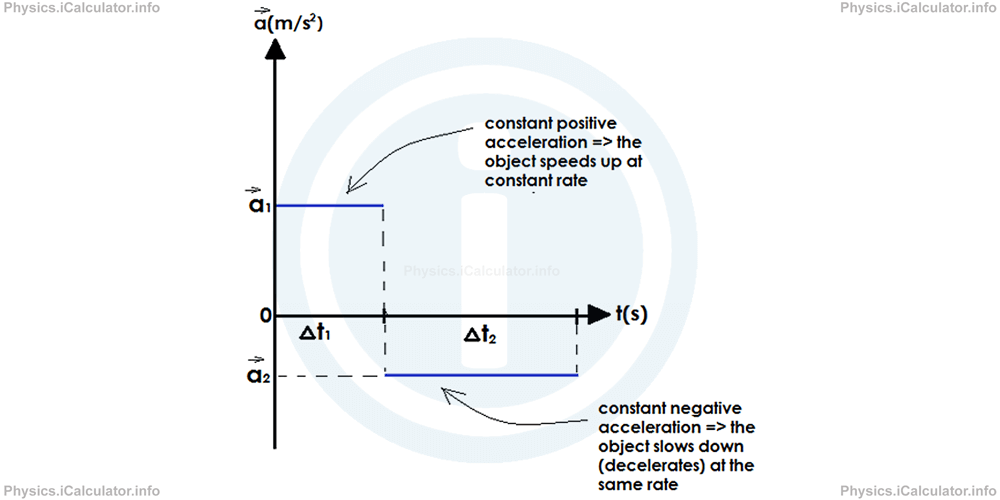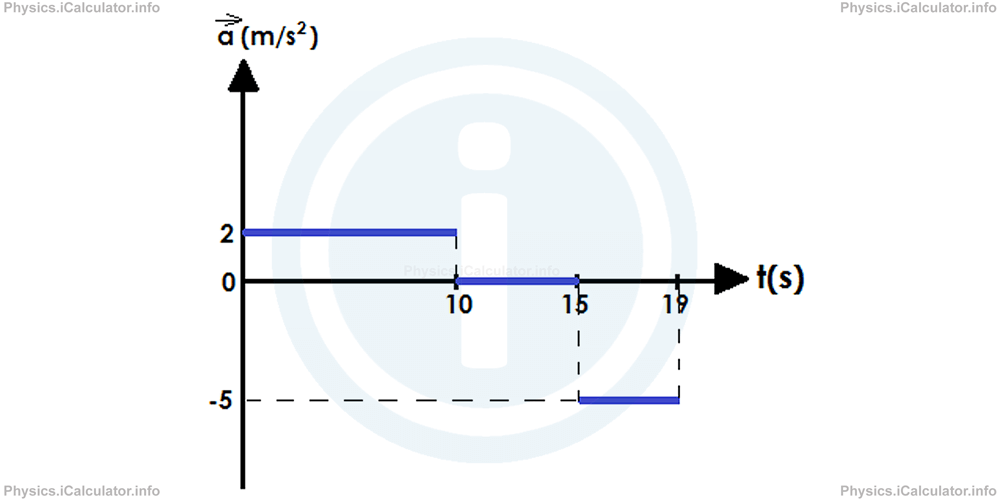Menu
Physics Lesson 3.11.2 - Acceleration verse Time graph in the uniformly accelerated (decelerated) motion
Please provide a rating, it takes seconds and helps us to keep this resource free for all to use
Welcome to our Physics lesson on Acceleration verse Time graph in the uniformly accelerated (decelerated) motion, this is the second lesson of our suite of physics lessons covering the topic of Acceleration v's Time Graph, you can find links to the other lessons within this tutorial and access additional physics learning resources below this lesson.
Acceleration verse Time graph in the uniformly accelerated (decelerated) motion
In the uniformly accelerated (decelerated) motion, the acceleration is constant but not zero. Therefore, it will not be any more at the horizontal axis as in the previous example but above or below it depending on the sign of acceleration, although it is still horizontal. This means when the acceleration is positive (the object is speeding up), the acceleration vs time graph will be a horizontal line above the time axis and when it is negative (while slowing down), the acceleration vs time graph will be a horizontal line below the time axis as in the figure below.

Example 2
An object starts moving from rest and while accelerating at the same rate during the first 10s, it reaches a velocity of 20 m/s. Then, it moves at constant velocity in the next 5 s before slowing down at the same rate for the next 4 s until it stops.
- Plot the acceleration vs time graph of the entire motion
- Calculate the total displacement of the object
Solution 2
First, we must calculate the acceleration in each interval. Thus, for the first interval (0 - 10 s), we have v⃗0 = 0, v⃗1 = 20 m/s and t1 = 10 s. Hence, the acceleration a⃗1 is
The same procedure is used for the next two intervals as well. Thus, if we denote the velocity at the end of the second interval as v⃗2, it is obvious in this interval the velocity is constant. Therefore, the acceleration is zero in this interval as
In the last interval, i.e. during the last 4s, the object slows down from v⃗2 = 20 m/s to v⃗3 = 0. Hence, we have
Therefore, the acceleration vs time graph for this motion will be:

Using the information provided in the clues, we can write for the displacement in each interval:
∆x⃗2 = (v⃗2 + v⃗1 ) × t2/2 = (20 m/s + 20 m/s) × 5 s/2 = 100 m
∆x⃗3 = (v⃗3 + v⃗2 ) × t3/2 = (0 m/s + 20 m/s) × 4 s/2 = 40 m
Therefore, the total displacement ∆x⃗tot is
= 100 m + 100 m + 40 m
= 240 m
You have reach the end of Physics lesson 3.11.2 Acceleration verse Time graph in the uniformly accelerated (decelerated) motion. There are 5 lessons in this physics tutorial covering Acceleration v's Time Graph, you can access all the lessons from this tutorial below.
More Acceleration v's Time Graph Lessons and Learning Resources
Whats next?
Enjoy the "Acceleration verse Time graph in the uniformly accelerated (decelerated) motion" physics lesson? People who liked the "Acceleration v's Time Graph lesson found the following resources useful:
- Accelerate Feedback. Helps other - Leave a rating for this accelerate (see below)
- Kinematics Physics tutorial: Acceleration v's Time Graph. Read the Acceleration v's Time Graph physics tutorial and build your physics knowledge of Kinematics
- Kinematics Revision Notes: Acceleration v's Time Graph. Print the notes so you can revise the key points covered in the physics tutorial for Acceleration v's Time Graph
- Kinematics Practice Questions: Acceleration v's Time Graph. Test and improve your knowledge of Acceleration v's Time Graph with example questins and answers
- Check your calculations for Kinematics questions with our excellent Kinematics calculators which contain full equations and calculations clearly displayed line by line. See the Kinematics Calculators by iCalculator™ below.
- Continuing learning kinematics - read our next physics tutorial: Motion in Two Dimensions. Projectile Motion
Help others Learning Physics just like you
Please provide a rating, it takes seconds and helps us to keep this resource free for all to use
We hope you found this Physics lesson "Acceleration v's Time Graph" useful. If you did it would be great if you could spare the time to rate this physics lesson (simply click on the number of stars that match your assessment of this physics learning aide) and/or share on social media, this helps us identify popular tutorials and calculators and expand our free learning resources to support our users around the world have free access to expand their knowledge of physics and other disciplines.